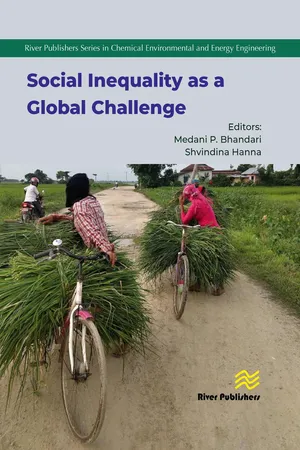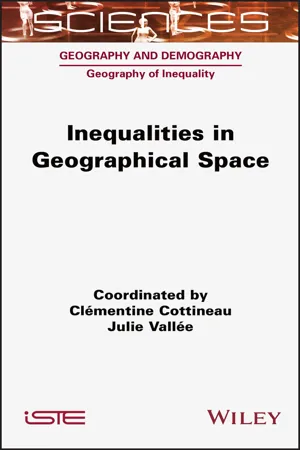Social Sciences
Dimensions of Inequality
Dimensions of inequality refer to the various aspects in which unequal distribution of resources, opportunities, and power can be observed within a society. These dimensions can include economic inequality, social inequality, gender inequality, racial inequality, and more. Understanding these dimensions is crucial for addressing and combating the systemic disparities that exist within a society.
Written by Perlego with AI-assistance
Related key terms
1 of 5
6 Key excerpts on "Dimensions of Inequality"
- eBook - PDF
- Medani P. Bhandari, Shvindina Hanna(Authors)
- 2021(Publication Date)
- River Publishers(Publisher)
307 Chapter 13 Conclusion: Social Dimensions of Inequality Medani P. Bhandari I nequality can be seen as a global communicable disease of human civ-ilization. Social inequalities are seen in the service sectors—access to healthcare, access to education, social protection, access to hous-ing systems, childcare, elderly cares etc. Another neglected but deep-rooted issue is cultural inequality, which segregates people from the mainstream. The minority groups face recognition problems of their social status, lan-guage, religion, customs, norms etc. The chapters of this book try to unveil the real picture of these issues with exemplary case studies from various countries. It is true that primarily the world is divided between haves and have-nots; and social strata are created as comfort zones to those who dominate the social, economic, and political systems. Such unequal strata can be grounded on innumerable factors—such as social, cultural, political, geographical, or due to environmental (anthropogenic or natural) catastrophe. On the basis of various case studies, this book encourages to rethink societal development through the lens of growing inequalities and disparities. The book presents new insights for evaluating the progress on social development, with the cov-erage of major inequalities due to gender, age, origin, ethnicity, disability, sexual orientation, class, and religion. The rules and regulations, social norms and values, are always created and implemented by the social elite; therefore, the marginalized groups have no or very minimal stake in the society, and they are always the victims. There is a need for a complete social, economic, and political reform to minimize 308 Social Inequality as a Global Challenge the designed division. Until or unless the marginalized group is empowered, the inequality issue cannot be solved or even minimized. - eBook - ePub
- Clementine Cottineau, Julie Vallee(Authors)
- 2022(Publication Date)
- Wiley-ISTE(Publisher)
1 The Spatial Dimension of Educational InequalitiesLeïla FROUILLOUCRESPPA-GTM, Université Paris-Nanterre, France1.1. Introduction
Educational inequalities can be understood as a specific type of social inequality, in that they involve institutional systems that play a crucial role in the construction of social trajectories. Meritocratic ideology, which goes hand in hand with the idea that each pupil should have access to the best possible education, can thus justify practices of differentiation (adapting curricula, creating streamed classes, suggesting school orientations corresponding to the “skills” of each pupil, etc.). As inequalities are always associated with a school system, the history of these systems plays a decisive role in understanding the ways in which socially differentiated schooling trajectories are constructed and justified. As Felouzis (2009, §3) reminds us, “each national education system constitutes a response to the universal and recurring problem of inter-individual inequalities linked to social stratification”. Using the French system as a starting point and comparing it with elements describing other school systems, this chapter shows how geographical approaches can contribute to an understanding of educational inequalities.This question is far from obvious, since the spatialization of social issues can present an obstacle to the analysis of the mechanisms producing inequalities (Tissot and Poupeau 2005). Indeed, the use of spatial categories – such as the neighborhood, priority education zones or schools in the Paris suburbs – can reinforce “a homogenizing vision of populations that are irreducibly different” (ibid., p. 8). Moreover, for Tissot and Poupeau, this spatialization “leads to thinking about the situation of the most segregated territories independently of overall mechanisms” (ibid., p. 5). How then can we construct a geographical approach that does not spatialize social issues, and that makes it possible to grasp the mechanisms of production of social inequalities at and/or through school1 - The chapter begins by placing poverty briefly but firmly in the context of socioeconomic inequality and social class. It then paints an impressionistic picture of the material impact of poverty in wealthy societies before turning to look at the ways in which the social divisions of gender, ‘race’ and disability shape and mediate how it is experienced. As Sandra Fredman points out, most ‘groups which suffer discrimination on status grounds are disproportionately represented among people living in poverty’ (2011: 567). In addition to structural inequalities, it considers how poverty is experienced at the two ends of the life-course – a notion that captures the complexity of individuals’ passage through a lifetime and is of particular relevance to a gendered understanding of poverty (Bennett and Daly, 2014; Bennett, 2015; Dermott and Pantazis, 2018) – childhood and old age. In practice, individual social divisions intersect and interact with one another and with phases of the life-course either to reinforce or to mitigate their individual impact (Bassel and Emejulu, 2018; Dermott and Main, 2018); but for ease of analysis they will be discussed separately here.The final dimension considered is spatial. This also raises an issue about the levels at which poverty is lived simultaneously: most basically, as an individual of a particular gender, ‘race’, ethnicity, religion, social class, age, sexual orientation and with or without disabilities; plus, in many cases, within a family or multiperson household, which can affect the degree and nature of poverty; and finally within the wider neighbourhood and the physical and social environment created by it (Burchardt et al., 2002). Moreover, power is exercised at these levels and beyond – from the micro-household to the macro-national/global – to exclude individuals and groups from access to adequate resources (Jordan, 1996).
Inequality, social class and polarization
John Scott has analysed this process of exclusion through the representation of deprivation and privilege as ‘polarised departures from the normal range of lifestyles that are enjoyed by the citizens of a society’ (1994: 173). Differential power and opportunity at each end of the hierarchy of inequality mean that ‘the deprived are excluded from public life; the privileged are able to exclude the public from their special advantages’ (1994: 151; see also Dorling 2015). Scott emphasizes that deprivation and privilege are distinct ‘conditions and social statuses’ and not simply rankings at the bottom and top of a statistical hierarchy (1994: 173). He concludes that the causes of poverty are inseparable from the causes of wealth (see also Ridge and Wright, 2008; Platt and Dean, 2016). This echoes R. H. Tawney’s famous dictum that ‘what thoughtful rich people call the problem of poverty, thoughtful poor people call with equal justice the problem of riches’ (1913). And when ‘the problem’ is thereby understood as inequality, it clarifies ‘the need for structural change’ (Titmuss, 1965, cited in Shildrick and Rucell, 2015: 34; see also O’Hara, 2020). - eBook - ePub
- Sarah Irwin(Author)
- 2005(Publication Date)
- Routledge(Publisher)
Certainly the processes underpinning the reproduction of social inequality are to a large degree hidden from view. However, this ‘hidden hand’ is an aspect of complexity and extant social processes, and not a specific outcome of late modern society. What we require is a more sufficient theorisation of the milieux through which, and processes by which, people reproduce inequalities even whilst, at the same time, generally disapproving of the extent of such inequality. In this chapter I focus on socio-economic inequalities and how they are perceived, exploring aspects of distributive justice and recent debates about class. I again focus on the gap, in recent analyses, between perceptions and dispositions at the level of the individual, and accounts of the general social structure. This analytic gap blocks understanding of social dynamics in the reproduction, and reshaping, of material social inequalities. In line with the arguments developed in relation to life course differentiation, ethnicity and gender, we need to reconceptualise social structural differentiation to achieve better analytic purchase on people’s diverse social positioning, and their perspectives upon it.Within research on social hierarchy, social milieux are very important yet under-researched Dimensions of Inequality and its reproduction. I will consider recent writing on redistribution and recognition by Nancy Fraser and Axel Honneth and argue that a sociologically grounded understanding of social position and perceived injustice requires a full specification of when and how extant conditions are subject to justice evaluations and experienced as unjust. Drawing on Runciman I will argue that whilst a matter for empirical investigation, reference groups and social comparison processes are crucial to conceptualising experiences of injustice and linked patterns of action, or inaction. It is crucial to better understand how people see their social position and link this to our knowledge of social structural inequalities. Without an analysis of social position it is unsurprising that we end up with models of disjuncture between the subjective and the objective, between perceptions and outlooks on the one hand and the structure of social relations on the other. In section 8.3 I review general data on perceptions of income inequalities and general inclinations which are more egalitarian than extant patterns of income distribution. I also discuss some empirical evidence on the ways in which social positioning entails diverse frames of reference. In section 8.4 I explore recent developments in debates about social class. Various writers here have presumed that people’s social position should provide them with a class identification. Since in practice many people do not readily identify in class terms, some writers have interpolated an ideological gap, or pattern of resistance, at the level of individuals. However, we can better understand people’s self-identification with a more nuanced understanding of their frames of reference. What is crucial is not just pointing to evidence of diverse frames of reference and subjectivities, but conceptualising the pattern of such diversity. To do so is to develop a more inclusive theory of the meshing of subjective views and perceptions and extant social relations. Consequently we can develop a more robust understanding of social inequality and its reproduction. - eBook - PDF
Rethinking Class
Cultures, Identities and Lifestyles
- Fiona Devine, Mike Savage, John Scott, Rosemary Crompton, Fiona Devine, Mike Savage, John Scott, Rosemary Crompton(Authors)
- 2017(Publication Date)
- Red Globe Press(Publisher)
24 2 Social Stratification and Social Inequality: Models of Intersectionality and Identity Floya Anthias We live in a world torn apart by inequality, conflict and injustice. Not only is there a global division in the very capacity to sustain life in different parts of the world, in what Hall (Hall et al . 1992) has called ‘the West and the rest’, with more than half the world living in poverty and disease, but there are conflicts manifested in war and other forms of violence, with people being pitted against each other in the name of nationalism, religion or territorial claims. This is only one arm of the divided world we live in. Within societies and nations, within so-called ‘communities’, there are divisions and conflicts around class, around ethnicity and racialisation, and around gender as well as other social categories and social positions. Moreover, old people, single mothers, those living on benefits, the long-term unemployed, the sick, the disabled are terms we use to describe both the boundaries we place between different categories of people (although as we shall see these are not mutually exclusive), categories embodied in state practices and regulations, and unequal economic and social positions around income, housing, employment opportunities, education, skills and social rights as well as forms of social honour and rank. In this quagmire of inequality what means do we have for their understanding? There are a number of terms in the sociological vocabulary that attach themselves to the understanding and explication of inequality. If ‘social inequality’ is the broad frame by which sociology identifies its object of reference, then social stratification is the most used para-conceptual means for identifying the issues at stake. Essentially social stratification conceptualises inequality as a process of layering or classifying according to a hierarchical principle. In this way social stratification points our attention to vertical rather than horizontal - eBook - ePub
Inequality in Economics and Sociology
New Perspectives
- Gilberto Antonelli, Boike Rehbein(Authors)
- 2017(Publication Date)
- Routledge(Publisher)
Part IIIDimensions of Inequality
Passage contains an image
7 Gender and inequality
Emanuelle SilvaThe category of gender has been closely associated with that of inequality right from the start. It was also closely linked to the political scene, since it was mainly promoted by feminist movements. We can distinguish three overlapping phases of the feminist movements, which relate to three different concepts of gender inequality. The first phase, starting in the nineteenth century, consisted of the emancipatory movements against limits of democracy and connected struggles against male domination with those against racism, colonialism, capitalism and others. The second phase rendered the discussion more academic and specialized. This also led to more sophisticated approaches to gender inequality. The third phase reconnects gender to other Dimensions of Inequality but also questions the assumptions of the earlier phases of the discussion.The category of gender was only developed in the course of these discussions, first as a means to distinguish the social construction of gender from the biological category of sex. It became evident, however, that this simple distinction had all kinds of theoretical implications and rested on problematic assumptions itself. Against this backdrop, the debates about gender have produced a great deal of literature that is relevant to the epistemology, political framing, methodology and empirical body of inequality research.This chapter will not summarize the history of research on gender. Neither will it give much attention to the political realm. It will rather focus on the theoretical implications of the discovery of the category itself and the debates around it. The first section deals with the concept, the second develops the social construction of gender, the third studies how this social construction is incorporated, while the fourth relates the notion of gender to that of class. The final section summarizes important aspects of contemporary debates about the concept of gender.
Index pages curate the most relevant extracts from our library of academic textbooks. They’ve been created using an in-house natural language model (NLM), each adding context and meaning to key research topics.





